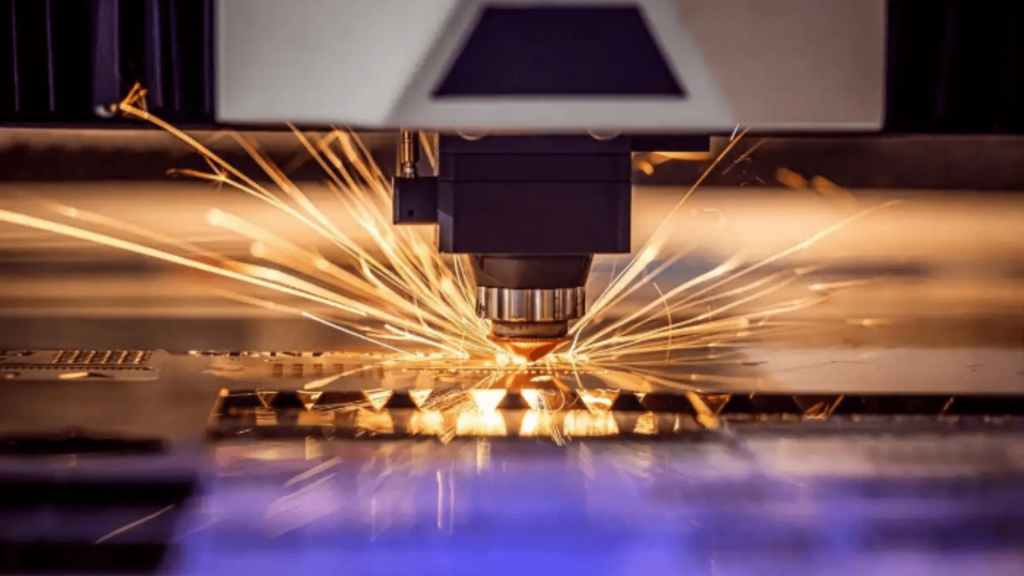Laser “carving” diamond: conquering the hardest material with light
Diamond is the hardest substance in nature, but it is not just jewelry. This material has a thermal conductivity five times faster than copper, can withstand extreme heat and radiation, can transmit light, insulate, and can even be transformed into a semiconductor. However, it is these “superpowers” that make diamond the “most difficult” material to process – traditional tools either cannot cut it or leave cracks. It was not until the advent of laser technology that humans finally found a key to conquer this “king of materials”.
 Imagine using a magnifying glass to focus sunlight to ignite paper. The principle of laser processing diamond is similar, but more precise. When a high-energy laser beam irradiates diamond, a microscopic “carbon atom metamorphosis” occurs:
1. Diamond turns into graphite: The laser energy changes the surface diamond structure (sp³) into softer graphite (sp²), just like a diamond instantly “degenerates” into a pencil lead.
2. Graphite is “evaporated”: the graphite layer sublimates at high temperature or is etched by oxygen, leaving precise processing marks.
3. Key breakthrough: defects In theory, perfect diamond can only be processed by ultraviolet laser (wavelength <229 nm), but in reality, artificial diamonds always have tiny defects (such as impurities and grain boundaries). These defects are like “holes” that allow ordinary green light (532 nm) or infrared laser (1064 nm) to be absorbed. Scientists can even “command” the laser to carve a specific pattern on the diamond by regulating the defect distribution.
Laser processing combines computer numerical control systems, advanced optical systems, and high-precision and automated workpiece positioning to form a research and production processing center. Applied to diamond processing, it can achieve efficient and high-precision processing.
1. Microsecond laser processing Microsecond laser pulse width is wide and is usually suitable for rough processing. Before the emergence of mode locking technology, laser pulses were mostly in the microsecond and nanosecond range. Currently, there are few reports on direct diamond processing with microsecond lasers, and most of them focus on the back-end processing application field.
2. Nanosecond laser processing Nanosecond lasers currently occupy a large market share and have the advantages of good stability, low cost, and short processing time. They are widely used in enterprise production. However, the nanosecond laser ablation process is thermally destructive to the sample, and the macroscopic manifestation is that the processing produces a large heat-affected zone.
3. Picosecond laser processing Picosecond laser processing is between nanosecond laser thermal equilibrium ablation and femtosecond laser cold processing. The pulse duration is significantly reduced, which greatly reduces the damage caused by the heat-affected zone.
4. Femtosecond laser processing Ultrafast laser technology brings opportunities for diamond fine processing, but the high cost and maintenance cost of femtosecond lasers limit the promotion of processing methods. At present, most related research remains in the laboratory stage.
Conclusion
From “unable to cut” to “carve at will”, laser technology has made diamond no longer a “vase” trapped in the laboratory. With the iteration of technology, in the future we may see: diamond chips dissipating heat in mobile phones, quantum computers using diamonds to store information, and even diamond biosensors implanted in the human body… This dance of light and diamonds is changing our lives.
Imagine using a magnifying glass to focus sunlight to ignite paper. The principle of laser processing diamond is similar, but more precise. When a high-energy laser beam irradiates diamond, a microscopic “carbon atom metamorphosis” occurs:
1. Diamond turns into graphite: The laser energy changes the surface diamond structure (sp³) into softer graphite (sp²), just like a diamond instantly “degenerates” into a pencil lead.
2. Graphite is “evaporated”: the graphite layer sublimates at high temperature or is etched by oxygen, leaving precise processing marks.
3. Key breakthrough: defects In theory, perfect diamond can only be processed by ultraviolet laser (wavelength <229 nm), but in reality, artificial diamonds always have tiny defects (such as impurities and grain boundaries). These defects are like “holes” that allow ordinary green light (532 nm) or infrared laser (1064 nm) to be absorbed. Scientists can even “command” the laser to carve a specific pattern on the diamond by regulating the defect distribution.
Laser processing combines computer numerical control systems, advanced optical systems, and high-precision and automated workpiece positioning to form a research and production processing center. Applied to diamond processing, it can achieve efficient and high-precision processing.
1. Microsecond laser processing Microsecond laser pulse width is wide and is usually suitable for rough processing. Before the emergence of mode locking technology, laser pulses were mostly in the microsecond and nanosecond range. Currently, there are few reports on direct diamond processing with microsecond lasers, and most of them focus on the back-end processing application field.
2. Nanosecond laser processing Nanosecond lasers currently occupy a large market share and have the advantages of good stability, low cost, and short processing time. They are widely used in enterprise production. However, the nanosecond laser ablation process is thermally destructive to the sample, and the macroscopic manifestation is that the processing produces a large heat-affected zone.
3. Picosecond laser processing Picosecond laser processing is between nanosecond laser thermal equilibrium ablation and femtosecond laser cold processing. The pulse duration is significantly reduced, which greatly reduces the damage caused by the heat-affected zone.
4. Femtosecond laser processing Ultrafast laser technology brings opportunities for diamond fine processing, but the high cost and maintenance cost of femtosecond lasers limit the promotion of processing methods. At present, most related research remains in the laboratory stage.
Conclusion
From “unable to cut” to “carve at will”, laser technology has made diamond no longer a “vase” trapped in the laboratory. With the iteration of technology, in the future we may see: diamond chips dissipating heat in mobile phones, quantum computers using diamonds to store information, and even diamond biosensors implanted in the human body… This dance of light and diamonds is changing our lives.